Social media will continue to be crucial to marketing success in 2025, but there’s a lack of credible guidance on how to craft a thoughtful strategy. In this guide, you’ll learn how to get started with paid ads on social.
Social’s Place in a Digital Marketing Strategy
Social is an important channel within your digital marketing strategy. Top of funnel ads do an excellent job at introducing brands to potential customers, and lower funnel ads compel users to convert. However, social is generally considered more of an upper funnel play when compared to a channel like SEM.
Another key difference is that social is a ‘push’ channel in which you’re trying to ‘push’ your message to new users, and SEM is a ‘pull’ channel because users are already searching for your products – the demand is already there.
Popular social platforms include Facebook, Instagram, TikTok, X, LinkedIn, Youtube, Pinterest, and Snapchat. Later we’ll dive into best practices for each of these platforms so you can drive success no matter which ones you choose to launch.
How Organic Social Content and Paid Social Ads Can Work Together
Organic social content is free to post and largely based on building a community around your brand. Paid advertising presents you with an opportunity to introduce your brand to new users and expand your reach beyond your organic community. This is important because the average reach of an organic Facebook post is only 2.6% of a page’s followers – if you have 10,000 followers, only about 260 will see your post.
The most obvious way to integrate organic and paid strategy is through boosting content. ‘Boosting’ is a tactic you can use after you identify a piece of existing organic content that has generated a significant amount of interest through video views or click-through rate. After you’ve selected the content, you can ‘boost’ it, which just means putting ad spend behind the content via your paid media campaigns to reach additional users.
5 Pillars for Success on Social
Before rushing to spend money on social media, it’s important to set yourself and your business up for success. If you incorporate all of the following pillars into your social strategy, you’re well-positioned for successful social media ad campaigns.
Goal Setting and Measurement
It’s hard to achieve results when you don’t know what your goal is in the first place. Understanding your business objective is critical in both the short and the long term for successful campaigns.
Most marketers these days are data-obsessed, and the data you receive from your ad results can inform your next campaign, tighten up your audience, and increase your ROAS (return on ad spend). Analytics is your friend and will help you make the most out of your social efforts to optimize current campaigns and inform future ad content and strategy.
When you set goals, you first need to align on what is the most important for your brand in the next 12 months. Some brands want hockey-stick growth and aren’t concerned with efficiency. Other brands want to keep scale low but be hyper-efficient. Most brands want to scale drastically while maintaining excellent efficiency.
You should have an honest conversation with your team about what is non-negotiable. Those non-negotiable metrics will usually involve total revenue, number of purchases, leads, or another metric that you can tie directly to your business’s bottom line. Once you have that solidified, you can discuss the ideal efficiency you want to hit with your paid spend.
Platform Selection
Social media platforms are not one-size-fits-all. The best platforms for your brand depend on your audience, budget, goal, and the creative assets you have available.
Social ads are pay-to-play, and you’ll want to factor in auction costs as well. For example, platforms that are older and more established, like Facebook, have a lot of competition. This competition drives up auction costs and makes advertising more expensive. If your audience is on a smaller platform with less competition, you should consider running media there to offset elevated CPMs (cost per 1,000 impressions) elsewhere.
Although you have several social platforms at your disposal, it doesn’t mean you should use all of them in your strategy. You want to find where your audience is spending their time and meet them there. Why would a children’s clothing brand advertise on Discord? Those mommy bloggers are gathering on Pinterest – but it takes crucial social media listening to confirm this.
When starting or revamping your current social media ads strategy, start by considering your top-performing organic channels. This is usually a good indication that you’re in the right place. Find out where your content performs best by looking at metrics like click-through rate and video views. Your marketing budget is likely finite, so it makes sense to invest in channels where you’re already seeing traction.
Audience Targeting
To ensure you’re getting the most out of your ad spend, knowing exactly who you’re targeting is crucial to social ad success. What’s the use in paying for ads and putting the effort into content creation if it’s not going to be seen by the right people and lead to high-intent consumers?
Targeting can go from extremely broad to exceptionally granular, and lookalike and retargeting makes it even more specific. Going beyond general targeting, you should evaluate your first-party data to understand more about your users and create personas.
You can start to develop personas as you ask deeper questions: What product lines do your customers purchase from? How often do they repurchase? Do they checkout with multiple items in the cart? Once you have your personas, you can more effectively target them and experiment from there. The more you test and experiment, the more you’ll learn about your audience.
Creative
Creative is the single most important lever at your disposal for social. Although targeting is important, it’s clear that platform algorithms are advancing to the point of prioritizing high-quality content in auctions, and it will be more likely to be served to users.
Your ad may be the first touchpoint a user has with your brand, and first impressions matter. The quality of your creative can determine whether they keep scrolling or pause to learn more about your product or brand. Creative is not only a way to communicate your message clearly, but also drive emotional connection and resonance through visuals, tone, and storytelling.
Consistently strong creative builds long-term brand equity and brand loyalists, which are priceless for any business.
Testing
Rapid experimentation is our secret sauce to sustainable growth marketing. Testing can take place across all areas of social ads including audience, graphics, placement, etc. You want a winning campaign strategy, and sometimes one minor change can bring your ROAS through the roof. It’s easy to rely on a winning asset, but even evergreen content will fatigue.
Analyze campaign performance first to get an understanding of what elements drive campaign performance. Is there certain imagery, in-asset copy, or products featured that tend to correlate with higher conversions? Rely on performance data instead of your gut or existing biases to analyze performance and decide what you want to test next. It’s important to iterate upon existing concepts to make them even stronger and also test net-new ideas to keep your creative fresh for your audience.
How to Build a Paid Social Strategy by Platform
- Campaign Overview
- Facebook Ads Manager
- TikTok Ads
- X Ads
- LinkedIn Ads
- YouTube Ads
- Pinterest Ads
- Snapchat Ads
Overview of a Paid Social Media Campaign
When planning any paid social strategy, there are three campaign types in which almost every platform organizes its ads campaigns. These are Awareness, Consideration, and Conversion.
If you need a brush-up, awareness is your Top of Funnel (TOF) campaign type that generates interest in your product or service. Marketers can increase brand awareness by telling people what makes their business valuable to them.
Consideration, or Middle of Funnel (MOF), is best for getting people to think about your brand and encouraging them to seek more information. The Bottom of Funnel (BOF) or Conversion campaign type is designed to encourage people who are interested in your product or service to take action via an app download or purchase.
Depending on the maturity of your brand, these goals will vary. Early stage brands will be focused on more TOF to bring about brand awareness while more legacy brands will be focused on more BOF conversion campaigns due to already being known entities.
Within these three campaign types, you’ll find various ad objectives that you can use to build your ad groups for targeting and individual ad assets. Your advertising objective is what you want people to do when they see your ads – you should tie these objectives back to your company’s overarching goals and specific OKRs in relation to your ad spend.
These are just a few of the objectives campaigns can include:
- Increase website traffic
- Build brand awareness
- Lead generation
- Boost engagement to page or posts
- Increase app installs
- Increase conversions
Facebook Ads Manager (Instagram Lives Here Too)

Meta has several properties – including Facebook and Instagram – under its umbrella company. Meta has more than 3 billion users worldwide, making it a powerhouse in the world of advertising.
Meta’s ads platform, Facebook Ads Manager, might be the OG of social advertising and comes in behind Google as the #2 digital ad seller in the US. Though iOS14 put a bit of a buzz kill on Facebook’s data tracking, marketers are still on trend to spend over $58 billion on Facebook advertising this year.
Social operations for both Instagram and Facebook are housed within Facebook Ads Manager. Though Facebook has traditionally held Meta’s market share in digital advertising, Instagram drove $70.9B in 2023 and has steadily increased year-over-year.
The Instagram audience is slightly younger than the Facebook audience. Instagram is used by 65% of Gen Z users, whereas Facebook is a bit lower at 56%.
So why use Facebook Ads? Facebook Ads are extremely versatile and offer up to 11 different variations you can use to solve a variety of business goals from driving traffic to your website to reaching people in your local area.

After selecting your campaign type and what to optimize for, there are a multitude of ad formats to compliment your campaign. Creative assets can be shared between a business’s Facebook and Instagram pages, making it a quick process for marketers to build campaigns.
Facebook offers photo ads, video ads, stories ads, carousel ads, slideshow ads, collection ads, messenger ads, and playable ads, while Instagram’s ad types include Stories, Reels, Instagram Shopping, and Branded Content Ads when working with creators.
**NoGood Tip: We like to start with a TOF campaign with video creative. This way, even if the user doesn’t engage with the asset, they’re still considered a video viewer and can later be retargeted.
TikTok Ads
Entering the U.S. market in just 2016, TikTok has amassed over 1.8 billion users worldwide, with the vast majority between the ages of 18-24. Though TikTok is known for its entertaining and playful content, its advertising capabilities cannot be underestimated for both DTC brands and B2B brands.
TikTok generated an estimated $16.1B in revenue in 2023, a 67% year-over-year increase. In comparison to its social media platform competitors, TikTok advertising still remains largely undersaturated by B2B brands, which positions it as a less competitive market with bigger returns.
TikTok launched its Business Center in 2020 and continues to roll out new ad optimizations and campaign types for businesses of all sizes and budgets. Any business account can run full-funnel campaigns via TikTok’s Ads Manager, but accounts that are considered “TikTok Partners” (brands that meet a minimum spend threshold) are paired with TikTok representatives that can assist with specific TikTok ad types. With the help of their rep, managed brands can run additional campaigns including branded hashtag campaigns, brand takeovers, and branded effects.
TikTok’s Ads Manager offers three levels of campaign types with several objectives to choose from.
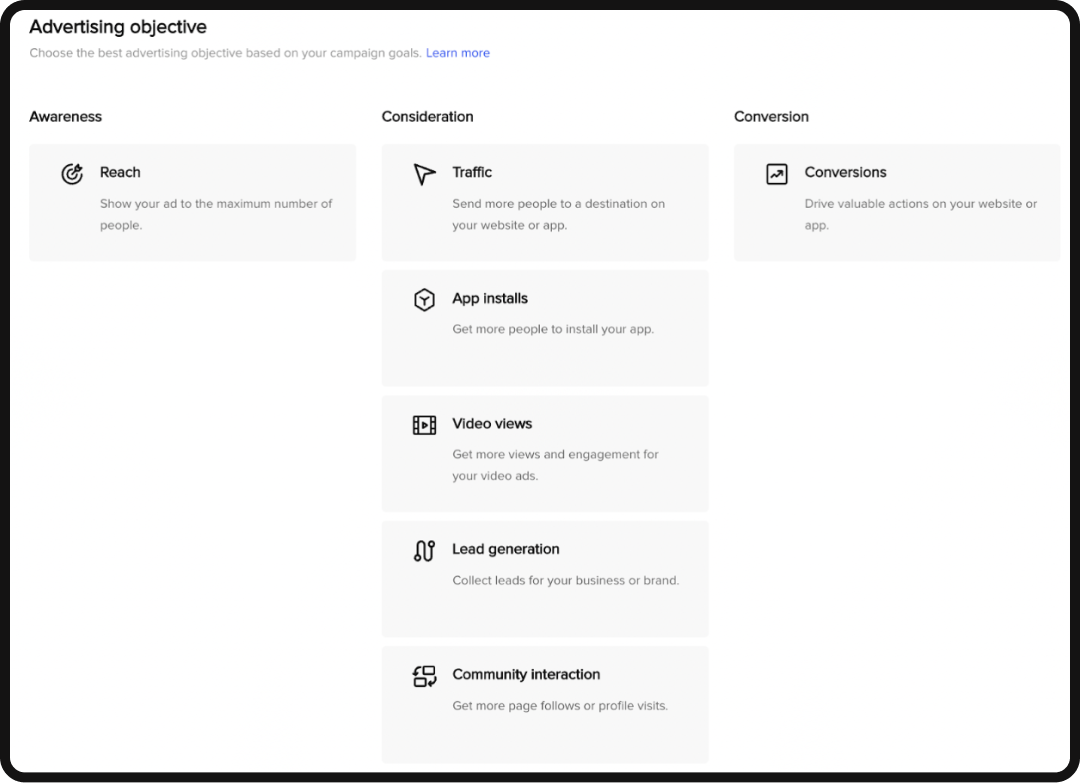
**NoGood Tip: We’ve noticed that it takes a bit for TikTok Pixel to learn and become efficient at retargeting; therefore, start with a TOF awareness campaign prior to working towards conversions.
Within the ad group creation, marketers can choose to target at a broad or granular level, including choosing audiences that are interested in specific hashtags or that have completed certain actions (watched till the end, liked, commented, shared, followed, or viewed profile).
An ad format unique to TikTok is Spark Ads. Spark Ads are assets that are posted organically first and then boosted within a campaign. Once the asset is posted organically, marketers can add an additional CTA linking to a landing page and push it out to their targeted and organic audience simultaneously.
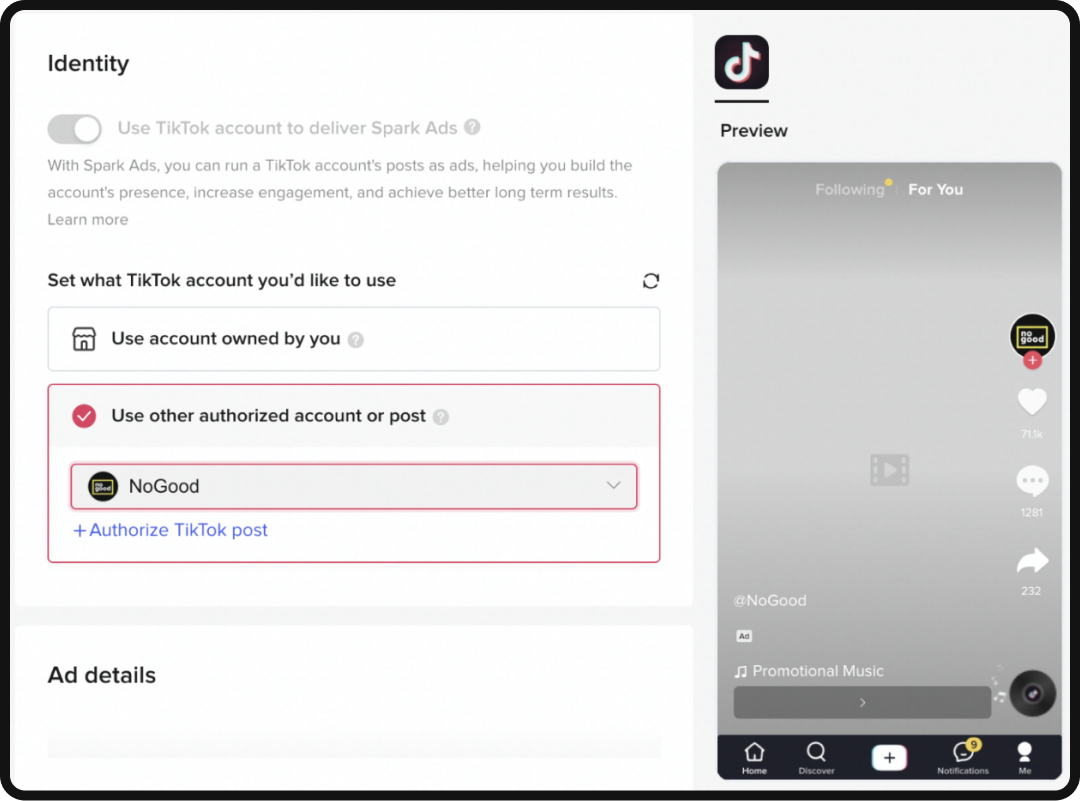
This is in opposition to a Dark Ad, which does not live on an account’s organic feed and only appears in front of the targeted audience. Dark Ads are a good option for accounts that do not have an organic TikTok presence or are optimizing for lead generation, app installations, or other conversions.
TikTok’s Spark Ads tend to drive stronger conversion rates vs. Dark Ads, which encourages accounts to build and maintain their organic presence while running social ads.
X (Formerly Known as Twitter) Ads
When building an X campaign, the three funnel objectives are the same as Meta’s Ads Platform, though underneath, you’ll find eight different objectives unique to X.
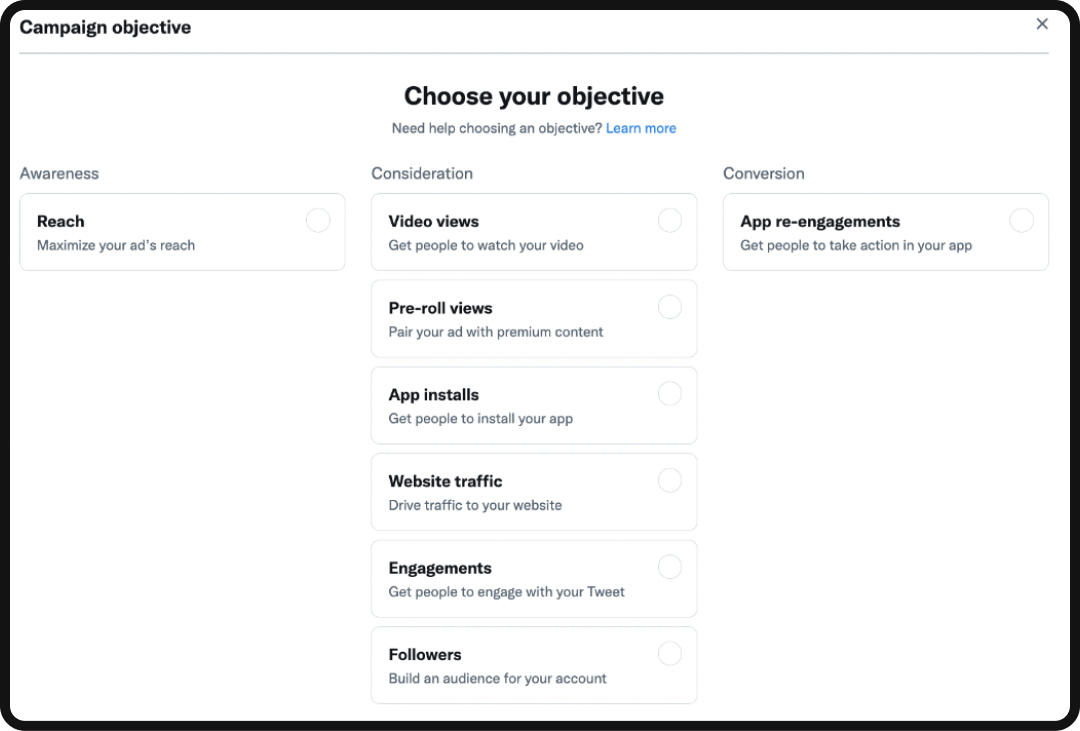
X ads are often seen as native in a user’s feed since their flagship ad format blends seamlessly into the feed (only marked as “promoted” to differentiate). Though this may be the most discreet ad format, X offers several other ad types that are more standard such as video and carousel.
Promoted tweets are best for awareness, driving website traffic, or promoting time-sensitive content such as giveaways. Video ads are best for storytelling, demonstrating a product in use, or displaying movement. Carousel ads work very well for e-commerce, app downloads, or multi-feature promotions because of the way they can tell a sequential story and encourage engagement.

Read our comprehensive X Ads Guide for more tactical strategies.
LinkedIn Ads
70% of users are confident LinkedIn delivers a positive ROI, ranking above Instagram and Facebook. Most effective in the B2B sector, LinkedIn is the best platform to get in front of specific industries, companies, or even people.
As the largest platform for business-minded interactions, LinkedIn values professional connections for individuals, while LinkedIn ads can drive traffic to your landing page, identify quality leads or potential employees, grow your page’s network, and show your expertise through thought-leadership.
As with the other social platforms we’ve examined, all three campaign objectives have a different core KPI, which will determine how your funds are distributed. Unlike Meta’s Ads Manager, LinkedIn works off of a “second-price” auction model, meaning you only pay one cent higher than the next bidder. Advertisers can set their max bid and adjust the allocation as they see fit.
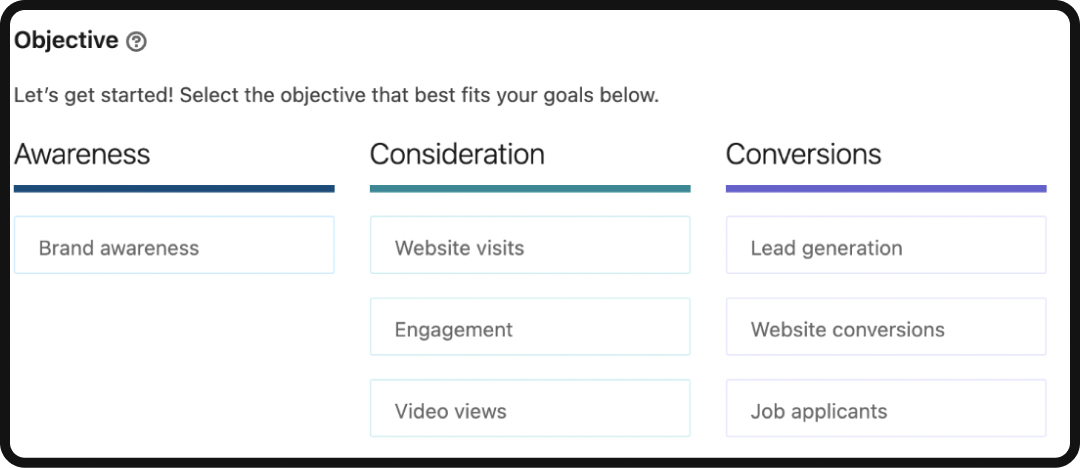
YouTube Ads
Over 40% of retail shoppers have bought products they watched YouTube videos about; the platform presents a massive opportunity to engage with and connect with audiences.
Users on YouTube can be targeted by channel, interest, search intent, placement, topic, location, age, and more, giving advertisers the ability to reach their target audience at an affordable rate.
YouTube Ads are actually built on the Google Ads dashboard. If you’re familiar with building Display or Search campaigns, you’ll already be familiar with the YouTube Ads interface.
Instead of selecting a traditional campaign type, marketers select a campaign goal followed by an ad format.
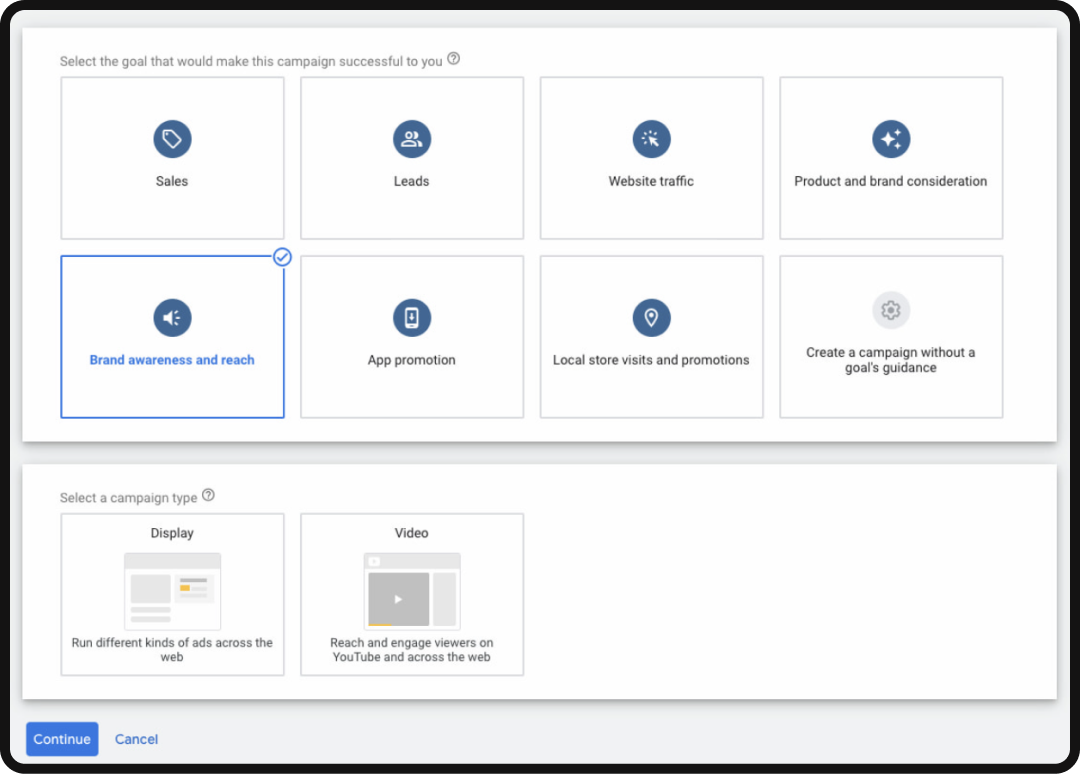
Similar to TikTok, YouTube offers unique ad formats specific to its platform, including overlay ads, bumper ads, responsive video ads, and skippable or non-skippable in-stream ads. All of these ad types offer unique opportunities to showcase your product in use, target users as granular as a specific YouTube channel or keyword, and create and maintain connections through introductory ads and retargeting (especially if non-skippable).
Pinterest Ads
Pinterest is a visually-driven, board-centric platform used for creative exploration and expression. Though few last-touch conversions come from this platform, it’s a powerful tool to leverage during the consideration phase.
Due to its authentic and creative nature, traditional ads used on other platforms may not work as well on Pinterest. Social ads on this platform must feel authentic and organic in order to drive performance since they appear among a user’s search results.
Pinterest offers three campaign types with limited options in objectives.

Its audience targeting is similar to those of other platforms, but we find it most similar to building a paid search campaign. Because Pinterest allows keyword targeting, we recommend leveraging Pinterest-provided resources including Pinterest Trends and Pinterest Predicts to help align your audience with the traffic Pinterest is reporting.
For more on Pinterest Ads, read our Complete Guide to Pinterest Marketing.
Snapchat Ads
Introduced in 2014, Snapchat’s advertising was built for large companies with deep pockets. Today, Snapchat has made it simpler and more affordable for brands of all sizes and budgets. Though it may not be top of mind in the realm of social media, Snapchat has been steadily growing year after year and has grown 7% from 2023 to 2024.
Depending on your campaign goals, Snapchat offers various ad formats under Awareness, Consideration, and Conversion objectives. With as little as $5 per day, ad formats range from single images or videos to story ads, AR lenses, filters, and commercials up to 3 minutes long.
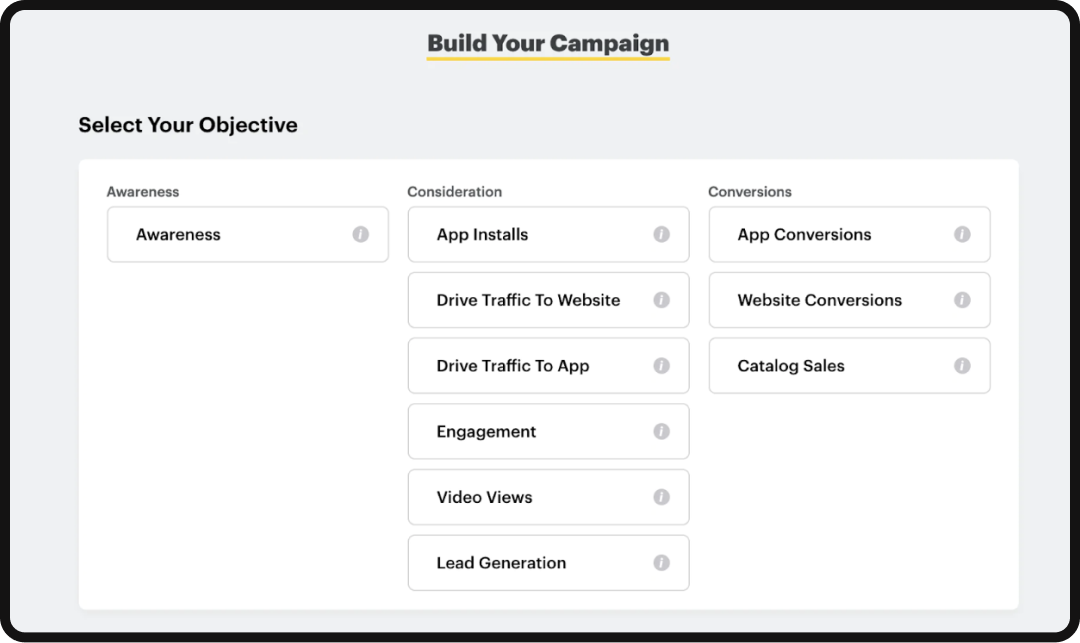
We recommend beginning with top-of-funnel awareness campaigns on Snapchat to nurture your audience before retargeting those that have interacted with you in a consideration or conversion campaign. Retargeting on Snapchat is done through an Ad Engagement Audience, which is a strategy that’s confined to actions taken only on Snapchat ads. This effectively helps move users down the funnel.
It’s Not One-Size-Fits-All
Though there are a multitude of social media platforms offering advertising services, not every platform will be right for your brand and audience. We recommend meeting your audience where they are, which you can figure out based on organic performance, social listening, and data-driven targeting.
But even when running ads on social media, the goal is to continue to resonate with your target audience and build your brand community. Social proof and the use of UGC have become increasingly powerful as users prefer to hear about a product from a trusted source instead of an overly curated social campaign.
Be sure to remain native to the platform you’re advertising on and monitor engagement, interaction, and brand sentiment that builds community and successful social ad campaigns.





